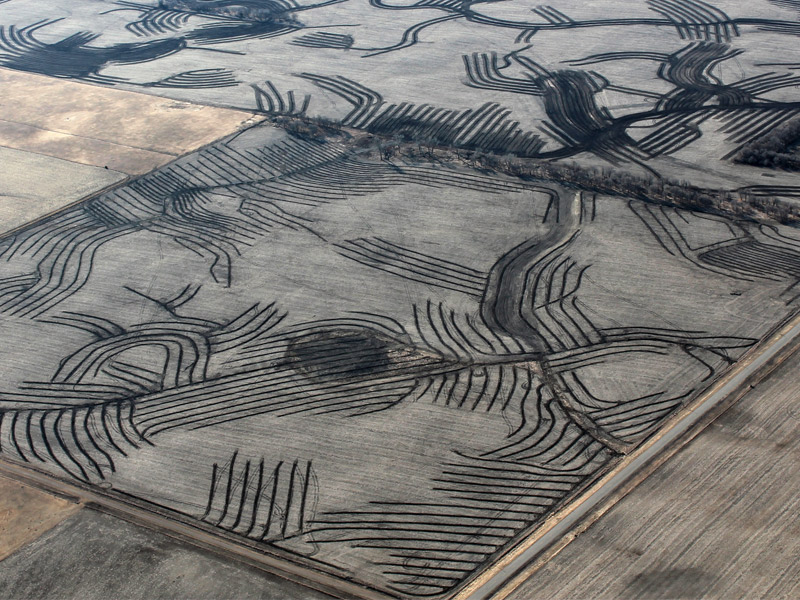Ag Drainage Services

Be ahead of schedule
By having poor soil your entire job can be put behind by weeks or even months. Get ahead of the game with valuable draining. This can allow you to get crops in or out ahead of the competition.
Tile drainage has been practiced on many soil textures. Sandier soils can be drained with deeper, widely spaced tile, but tend to need sock filters to prevent soil particles from entering the tile. Soils with a higher clay content can also be drained but require tile to be placed shallower and closer together. A typical design for a Fargo clay or Clearwater clay loam soil might be a depth of 4 feet with a spacing of 25 feet, whereas tile spacing for an Ulen fine sandy loam would be closer to 100 feet. Soils where shrinking/ swelling clays or are peat predominate may need special consideration with regard to tile drainage.
Level fields can be drained as long as minimum grades of 0.05 to 0.1% are maintained for tile laterals. A tile at 0.1% grade has 1 foot of fall per thousand feet. On level ground, this means that the tile depth would vary by 1 foot over 1000 ft. A typical drainage system provides an outlet where tile can drain freely (by gravity) into a surface ditch. Where topography does not allow for a gravity outlet, pumped outlets are used, provided a surface waterway exists to discharge the drainage water. A pumped outlet or "lift station" provides the lift required to get the drainage water from the elevation of the tile to the ground surface and into the receiving waterway. Pumped outlets add to the initial outlay and operation/maintenance costs of the drainage system, but have proven to be economically feasible in many situations. A pumped outlet station includes sump, pump, and discharge pipe. Important design features include size and shape of sump and capacity of the pump.
Often, the major source of “damage” from inadequate drainage relates to the timeliness of field operations. Inadequate drainage can delay spring field operations from days to a week or more. Occasional wet spots also interrupt field traffic patterns and cause field operations to be less uniform. Vehicle traffic on soils that are too wet will cause increased soil compaction. Delays in planting mean a shorter growing season for the crop. Once the crop is planted, inadequate drainage can cause stunted and shallow root growth, and sometimes, complete crop failure due to excess water stress (lack of oxygen in root zone). Planting delay, soil compaction, and excess water stress, combined, can translate into significant crop yield impacts. The magnitude of the yield impact for a growing season depends on crop and variety, soils, and the season’s rainfall pattern.
The economics of tile drainage systems depend on crop yield response, the initial capital outlay for the materials and installation of the system, and any annual operation and maintenance costs (pumped outlets) involved. While crop yield response to drainage can be assessed directly, the impacts of inadequate drainage on soil quality (structure, microbial activity, etc.) are more difficult to measure and assign economic value. Most field crops show a positive response to drainage, often with the best response from a combination of surface and tile drainage. The level of yield increase for a given year depends greatly on how poorly drained the soil was prior to drainage, and seasonal rainfall. Typical yield increases might be 10-30 bu/ac for corn and 5-10 bu/ac for soybeans. Wheat has been shown to yield only 58% of potential yield and sugarbeets 71% of potential yield when the water table is 15”-20” below the surface for long periods of time, on a clay loam soil. Drainage systems can return the cost of investment in 3 to 10 years.
Tile drainage will cause soils to warm up and dry out faster in the spring. Fields with intermittent wet spots will dry out more uniformly. Spring field operations on tiled fields will most likely be possible at an earlier date than fields without tile drainage.
It is important to remember that tile drainage does not remove plant available water from the soil. Clearly, the greatest benefits of tile drainage are realized in wet years--but because drainage promotes deep root development, crops will have better access to soil moisture in dry years. During extremely dry years it is conceivable that a tile-drained field might have less available water at some point during the growing season than an undrained field. Whether or not this would offset the early-season positive effects of drainage is unknown. In general, where poorly drained soils exist, crop yields will be more uniform from year to year with tile drainage.
The impacts of tile drainage are a mixed bag with respect to water quality—some positive and some negative. In general, phosphorus and sediment losses from tile drained field decrease, while losses of nitrate nitrogen and other dissolved constituents may increase. The extent of the increase or decrease depends on farm management practices.
Surface drainage increases peak surface runoff flow rates. Tile drainage typically reduces both volume and peak of surface runoff from agricultural fields. Studies show that the overall volume of water lost (surface runoff and tile flow combined) from a tile-drained field may increase slightly (5-15%), compared to fields with surface drainage only. Flooding is generally dependent on peak surface runoff rate. Because tile drainage tends to decrease peak runoff rates, this suggests that tile drainage should not increase (and may decrease) the incidence of flooding. Flooding, in general, is a watershed-scale phenomenon, and the effects of tile drainage at this scale are not as well understood as the field scale.
This is certainly an option, but one that must be carefully considered. One of the most important considerations of your tile installer is experience and familiarity with design procedures and standards for tile drainage systems. Depth, grade, pipe size, and field layout are all extremely important in design and will determine the quality of performance of your system. Another important consideration is installation method. Although pull-type and tractor mounted tiling machines can often be made to perform adequately, they do face limitations in the field that, when improperly accounted for, can result in both installation and performance, problems. The lifespan of corrugated plastic tile can be quite long—decades, if not generations. Once the tile is in the ground, it's there to stay, so make sure the installation is done correctly to avoid performance and longevity problems!
